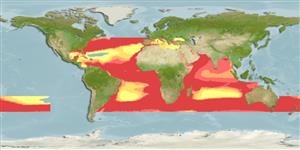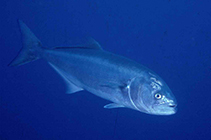Ajouter votre observation dans Fish Watcher
| Native range | All suitable habitat | Point map | Year 2050 |

|
| This map was computer-generated and has not yet been reviewed. |
| Pomatomus saltatrix AquaMaps Data sources: GBIF OBIS |
Common names from other countries
Classification / Names Noms communs | Synonymes | Catalog of Fishes(Genre, Espèce) | ITIS | CoL | WoRMS | Cloffa
> Scombriformes (Mackerels) > Pomatomidae (Bluefishes)
Etymology: Pomatomus: Greek, poma, -atos = cover, operculum + Greek, tomos = portion (Ref. 45335).
More on author: Linnaeus.
Etymology: Pomatomus: Greek, poma, -atos = cover, operculum + Greek, tomos = portion (Ref. 45335).
More on author: Linnaeus.
Environment: milieu / climate zone / depth range / distribution range Écologie
marin; saumâtre; océanodrome (Ref. 51243); profondeur 0 - 200 m (Ref. 54708). Subtropical; 53°N - 44°S, 98°W - 180°E
Distribution Pays | Zones FAO | Écosystèmes | Occurrences | Point map | Introductions | Faunafri
Circumglobal: In tropical to subtropical waters; except the eastern Pacific (Ref. 33390). Eastern Atlantic: Portugal to South Africa, including the Mediterranean and Black Sea, Madeira, and the Canary Islands. Western Atlantic: Canada and Bermuda to Argentina (Ref. 7251). Indian Ocean: along the coast of East Africa, Madagascar, southern Oman, southwest India, the Malay Peninsula, and Western Australia (Ref. 11441). Southwest Pacific: Australia except the Northern Territory, and New Zealand (Ref. 11441). Absent from eastern Pacific and northwest Pacific. Barely entering the Western Central Pacific region. Records from the Northern Territory, Australia and from Indonesia appear to be erroneous (Ref. 9860). Occurrence in Taiwan (Ref. 5193) and Hawaii (Ref. 4517) need verification.
Length at first maturity / Taille / Poids / Âge
Maturity: Lm 30.0 range ? - ? cm
Max length : 130 cm TL mâle / non sexé; (Ref. 11441); common length : 60.0 cm TL mâle / non sexé; (Ref. 3482); poids max. publié: 14.4 kg (Ref. 4699); âge max. reporté: 14 années (Ref. 128525)
Max length : 130 cm TL mâle / non sexé; (Ref. 11441); common length : 60.0 cm TL mâle / non sexé; (Ref. 3482); poids max. publié: 14.4 kg (Ref. 4699); âge max. reporté: 14 années (Ref. 128525)
Description synthétique Clés d'identification | Morphologie | Morphométrie
Épines dorsales (Total) : 8 - 9; Rayons mous dorsaux (Total) : 23 - 28; Épines anales: 2 - 3; Rayons mous anaux: 23 - 27. Jaw teeth prominent, sharp, compressed, in a single series. Two dorsal fins, the first short and low, with 7 or 8 feeble spines connected by a membrane. Back greenish, sides and belly silvery (Ref. 9860).
Occur in oceanic and coastal waters (Ref. 26340). They are most common along surf beaches and rock headlands in clean, high energy waters, although adults can also be found in estuaries and into brackish water (Ref. 6492). Small fish may be found in shallow coastal waters at least 2 m depth (Ref. 9563), in schools pursuing and attacking small fishes (Ref. 9626). Adults are in loose groups, often attacking shoals of mullets or other fishes and destroying numbers apparently far in excess of feeding requirements (Ref. 9860). Feed on other fish (Ref. 5377), crustaceans and cephalopods (Ref. 47377). Associated with sharks and billfishes (Ref. 26340). Voracious and aggressive (Ref. 9626), reported to bite when handled. Migrate to warmer water during winter and to cooler water in summer (Ref. 9987). Popular game fish (Ref. 6638). Good food fish; marketed mostly fresh (Ref. 9860), but also dried or salted (Ref. 5284), and frozen (Ref. 9987).
Life cycle and mating behavior Maturité | Reproduction | Frai | Œufs | Fécondité | Larves
Fecundity varies from 400,000 to 2,000,000 eggs depending on the size of the individual (ranging from 370,000 in a 31 cm fish to 1,240,000 in a 54 cm fish) (Ref. 27695).
Tailor are serial spawners (Ref. 6390).
Référence principale
Upload your references | Références | Coordinateur | Collaborateurs
Dooley, J.K., 1990. Pomatomidae. p. 721-722. In J.C. Quero, J.C. Hureau, C. Karrer, A. Post and L. Saldanha (eds.) Check-list of the fishes of the eastern tropical Atlantic (CLOFETA). JNICT, Lisbon; SEI, Paris; and UNESCO, Paris. Vol. 2. (Ref. 9986)
Statut dans la liste rouge de l'IUCN (Ref. 130435: Version 2024-2)
Vulnérable, voir Liste Rouge IUCN (VU) (A2bd); Date assessed: 07 July 2014
Utilisations par l'homme
Pêcheries: hautement commercial; Aquaculture: commercial; pêche sportive: oui; appât: usually
FAO(Aquaculture systems: production; pêcheries: production, Résumé espèce; publication : search) | FishSource | Sea Around Us
Plus d'informations
Trophic ecology
Éléments du régime alimentaire
Composition du régime alimentaire
Consommation alimentaire
Food rations
Prédateurs
Éléments du régime alimentaire
Composition du régime alimentaire
Consommation alimentaire
Food rations
Prédateurs
Population dynamics
Paramètres de croissance
Max. ages / sizes
Length-weight rel.
Length-length rel.
Fréquences de longueurs
Mass conversion
Recrutement
Abondance
Paramètres de croissance
Max. ages / sizes
Length-weight rel.
Length-length rel.
Fréquences de longueurs
Mass conversion
Recrutement
Abondance
Life cycle
Reproduction
Maturité
Fécondité
Frai
Spawning aggregations
Œufs
Développement de l'œuf
Larves
Dynamique des populations larvaires
Reproduction
Maturité
Fécondité
Frai
Spawning aggregations
Œufs
Développement de l'œuf
Larves
Dynamique des populations larvaires
Physiology
Body composition
Nutrients
Consommation d'oxygène
Type de nage
Vitesse de nage
Visual pigments
Fish sound
Diseases & Parasites
Toxicity (LC50s)
Body composition
Nutrients
Consommation d'oxygène
Type de nage
Vitesse de nage
Visual pigments
Fish sound
Diseases & Parasites
Toxicity (LC50s)
Human related
Aquaculture systems
Profils d'aquaculture
Souches
Ciguatera cases
Stamps, coins, misc.
Aquaculture systems
Profils d'aquaculture
Souches
Ciguatera cases
Stamps, coins, misc.
Outils
Bio-Quiz | E-book | Guide de terrain | Générateur de fréquences de longueur | Outil de dynamique de population | Carte par point | Classification Tree
| Catch-MSY |
Articles particuliers
Télécharger en XML
Sources Internet
Aquatic Commons | BHL | Cloffa | BOLDSystems | Websites from users | FishWatcher | CISTI | Catalog of Fishes(Genre, Espèce) | DiscoverLife | ECOTOX | Faunafri | Fishtrace | GenBank(génôme, nucléotide) | GloBI | GOBASE | GoMexSI (interaction data) | | Google Books | Google Scholar | Google | IGFA World Record | MitoFish | Bases de données nationales | OsteoBase(skull, spine) | Otolith Atlas of Taiwan Fishes | Aquariums publics | PubMed | Reef Life Survey | Scirus | SeaLifeBase | Arbre de Vie | Wikipedia(aller à, chercher) | World Records Freshwater Fishing | Zoological Record
Estimates based on models
Preferred temperature (Ref. 115969): 8.4 - 27.5, mean 21.1 (based on 1273 cells).
Phylogenetic diversity index (Ref. 82804): PD50 = 1.5000 [Uniqueness, from 0.5 = low to 2.0 = high].
Bayesian length-weight: a=0.01072 (0.00844 - 0.01360), b=2.96 (2.89 - 3.03), in cm Total Length, based on LWR estimates for this species (Ref. 93245).
Niveau trophique (Ref. 69278): 4.5 ±0.3 se; based on diet studies.
Résilience (Ref. 120179): Milieu, temps minimum de doublement de population : 1,4 à 4,4 années (K=0.10-0.2; tm=2; tmax=9; Fec=1 million).
Prior r = 0.47, 95% CL = 0.31 - 0.71, Based on 3 full stock assessments.
Fishing Vulnerability (Ref. 59153): Moderate vulnerability (42 of 100).
Climate Vulnerability (Ref. 125649): Moderate to high vulnerability (46 of 100).




